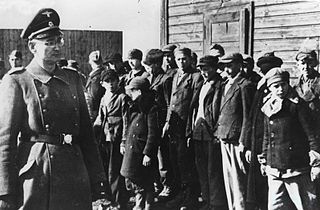Heuaktion

The Heuaktion (German: literally: harvesting of hay, or hay operation)[1] was a Nazi German World War II operation, in which 40,000 to 50,000 Polish children aged 10 to 14 were kidnapped by the German occupational forces and transported to Germany proper as slave labourers.[2] The term "heuaktion" was an acronym for homeless, parent-less and unhoused (heimatlos, elternlos, unterkunftslos, i.e. "HEU", or the hay action).[3] After arriving in Germany, the children were handed over to Organisation Todt and the Junkers aircraft works. The intention of the mass abduction was to pressure the adult populations of the occupied territories to register as workers in the Reich, and to weaken the “biological strength” of the areas of the Soviet republics which Germany had invaded.[4]
Background
Alfred Rosenberg, head of the Reich Ministry for the Occupied Eastern Territories, originally feared that targeting children aged 10 to 14 would be seen as simple abduction, and proposed instead kidnapping older children aged 15 to 17.[5] However, the actions of the German 9th Army induced him to consent to the kidnapping of younger children.[4]
The children were transferred to special camps for children called Kindererziehungslager, where the Germans selected children whose racial traits made them suitable for Germanization. Children considered racially unsuitable were sent either to forced labour or to concentration camps, including Auschwitz, after the destruction of their birth certificates.[6]
The children were kidnapped by the Army Group Centre and the 2nd Army, whose Chief of Staff, Henning von Tresckow, signed the order to abduct the children on 28 June 1944.[7]
The operation reached its peak in 1944, but due to the outcome of the war the kidnappings were not fully carried out.[8]
Post war
The Nuremberg trials classified the kidnapping of children as part of the Nazi program of systemic genocide.[9]
See also
- Forced labour under German rule during World War II
- Generalplan Ost
- Germanisation
- Kidnapping of Eastern European children by Nazi Germany
- Untermensch
- Genocide
References
- ^ Hannes Heer; Klaus Naumann (2004). War of Extermination: The German Military in World War II. Berghahn Books. p. 139. ISBN 1571814930. Retrieved 20 May 2015.
- ^ Roman Hrabar (1960), Hitlerowski rabunek dzieci polskich (1939-1945), page 99.
- ^ Lower, Wendy (2005), Nazi empire-building and the Holocaust in Ukraine, UNC Press Books, p. 117, ISBN 978-0-8078-2960-8
- ^ a b Lynn H. Nicholas, Cruel World: The Children of Europe in the Nazi Web p 351 ISBN 0-679-77663-X
- ^ Nazi Conspiracy and Aggression. Vol. III. Washington: United States Government Printing Office. 1946. p. 71 (doc. 031-PS). Online edition, Internet Archive.
- ^ Wasser, Bruno (1993). Himmlers Raumplanung im Osten: Der Generalplan Ost in Polen 1940-1944. Stadt, Planung, Geschichte (in German). Basel/Berlin: Birkhäuser. p. 221. ISBN 978-376432852-8.
- ^ Men of 20 July and the War in the Soviet Union Christian Gerlach in War Of Extermination: The German Military In World War II page 139
- ^ "Herrenmensch" und "Bandit" Deutsche Kriegsführung und Besatzungspolitik als Kontext des sowjetischen Partisanenkrieges(1941-44)Timm C. Richter page 106
- ^ Trials of War Criminals Before the Nuernberg Military Tribunals. Vol. V. Washington: United States Government Printing Office. 1950. p. 89. Online edition, Internet Archive.
